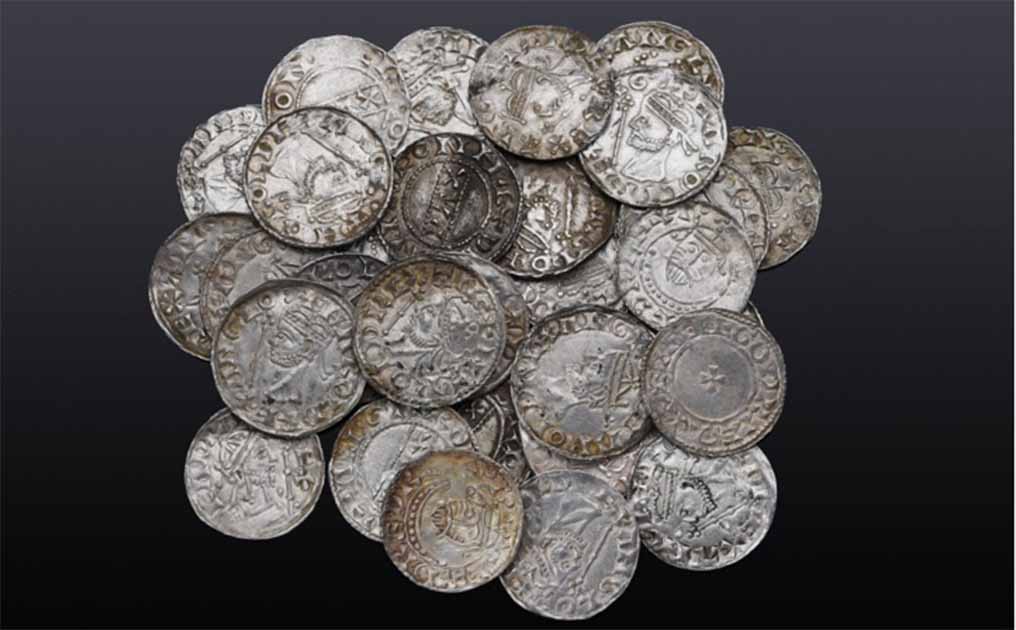Anglo-Saxon Pennies Auctioned For A Whopping $400,000
At a recent auction held at Noonans Mayfair in London, a hoard of 122 Anglo-Saxon pennies, discovered near Braintree in Essex by two metal detectorists in 2019, fetched a whopping £325,560, or just over $400,000! These coins, believed to have been buried in 1066 during the historic battle between English and Norman armies for the throne of England, likely remained hidden due to the demise of their owner in battle. In fact, all but two of the coins are believed to have been minted during or the years around 1066.
During the Battle of Hastings: A Whopping Markup
Noonans Coin specialist Bradley Hopper explained that:
“Twelve shillings was a considerable sum of money, and its retrieval must have been prevented by some great personal misfortune; we cannot say with any certainty whether or not the Braintree hoard’s owner died fighting at Hastings, but it is a tantalising possibility.”
Initially anticipated to reach up to £180,000, the final selling price far exceeded expectations! The proceeds from the auction will be shared among the two finders and the landowner, reports The BBC. "We are delighted with the results which is a life-changing amount of money for the finders,” said the landowners after attending the sale.
According to Hopper, the collection included an "extremely rare" Harold II penny from the Guildford moneyer Leofwold, with a guide price initially set between £4,000 to £5,000. This penny, minted in Huntington, surpassed expectations and ended up selling for almost £11,000.
Sixteen of the coins, including two 11th-century Byzantine coins, were acquired by Colchester Museum and the Fitzwilliam Museum in Cambridge, as per the treasure process under the terms of the 1996 Treasure Act.
- Who were the Anglo-Saxons? Peaceful Settlers or Barbarians?
- How Did it All Begin? The Rich Origins of the English Language

A rare, Harld II penny like this, from 1066 sold for £11,000 ($14000). (Noonans)
Nigel Mills, Artefact and Coin Expert at Noonans, said:
“Wow, this has exceeded all our expectations. The atmosphere in the packed saleroom was euphoric with bidders - in person and online - wanting to purchase just one example from this important collection.”
The auction's highest price went to a remarkably rare single specimen from the Hastings mint, which fetched a hammer price of £24,000 ($30,500). This amount far exceeded its pre-sale high estimate of £5,000-6,000 ($7,600-8,900), marking a significant appreciation in value.
Method to the Madness
The two detectorists, exploring together for two decades, had previously unearthed only copper coins and crotal bells in the same field area. Their luck changed when a signal from the Minelab CTX 3030 detected a silver penny buried just four inches below the surface, reports The Daily Mail.
Initially unrecognizable, they soon discovered half a dozen more within a 30-meter radius, realizing by evening that these were rare pennies dating back to the era of Harold II. Continuing their efforts over the next few days, they discovered 70 more coins. This successful excavation was repeated in 2020, resulting in the unearthing of another 70 coins!
Their methodical approach unearthed a total of 144 coins, dating from the last two Anglo-Saxon kings of England—Edward the Confessor and Harold II Godwinsson. The coins hailed from various towns and cities across England, including London, Cambridge, Canterbury, Ipswich, Chichester, Guildford, Worcester, Lincoln, Huntingdon, and Maldon in Essex, as well as rare mints like Sudbury in Suffolk and Bridport in Dorset.
In late 2023, the remaining coins were disclaimed and returned to the finders, concluding the remarkable saga of the Braintree Hoard.
- The Norman Invasion: An Epic 11th Century Battle for the English Throne
- A Red Dawn Rises - The Battle of Hastings, 1066
Notable Anglo Saxon Coin Hoards
One of the most notable Anglo-Saxon coin hoards discovered in England is the Cuerdale Hoard, uncovered near Preston, Lancashire, in 1840. This massive hoard contained over 8,500 coins, predominantly silver pennies, along with bullion and hack-silver, and is one of the largest Viking Age hoards ever found. Dating to the 9th century, the Cuerdale Hoard is believed to have been buried during a period of Viking incursions into Anglo-Saxon England.
Another significant find is the Watlington Hoard, discovered in Oxfordshire in 2015. This hoard, consisting of over 200 Anglo-Saxon silver pennies, is notable for its exceptionally high silver content and the presence of rare coins from the reign of King Alfred the Great. The Watlington Hoard sheds light on the monetary system and economic activity in late Anglo-Saxon England.
Top image: The Braintree hoard of 122 Anglo-Saxon pennies, found in Essex, England. Source: Noonans
By Sahir Pandey
References
Best, S. 2024. Talk about striking gold! Hoard of 122 Anglo-Saxon coins found by two metal detectorists in Essex sells at auction for more than £325,000. Available at: https://www.dailymail.co.uk/sciencetech/article-13113225/Talk-striking-gold-Hoard-122-Anglo-Saxon-coins-two-metal-detectorists-Essex-sells-auction-325-000.html.
Hainey, F. 2024. Metal detectorists who found Anglo-Saxon coins sell hoard for more than £325,000. Available at: https://www.manchestereveningnews.co.uk/news/uk-news/metal-detectorists-who-found-anglo-28683200.
Russell, S. 2024. Hoard of Anglo-Saxon coins found by two metal detectorists fetch £325,000 at auction. Available at: https://www.standard.co.uk/news/uk/anglo-saxon-coins-braintree-essex-auction-hoard-detectorists-b1140762.html.

















